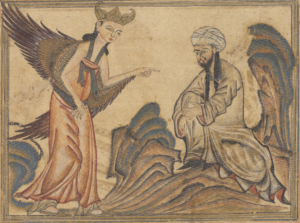
The Prophet Muhammad receiving revelation from the Archangel Gabriel, as illustrated by Rashid al-Din Hamadani
Last week, the news cycle blew up a story coming out of a small university in Saint Paul, Minnesota, where an adjunct art history professor was, in effect, fired over an image she presented in her classroom. And while the incident itself has received much attention from journalists, commentators, and politicians, the reaction and backlash in the wake of the incident are far more important. Erika López Prater taught a global art history class at Hamline University. One day, in her class, her presentation and lecture featured a 14th-century image of the Prophet Muhammad. If you’re unfamiliar, according to Islamic law, producing or displaying an image of the prophet is strictly forbidden, as it is considered sacrilegious. Because of this, a Muslim student complained to the school’s administration; consequently, they have not renewed López Prater’s contract.
Many news sites have latched onto this story, claiming that sensitive young people and religious zealots stifle free speech on our college campuses and that this is only the most recent incident. However, while I disagree with the actions taken by the university administration, I voice my opposition in a very different way, coming from a very different place than those commentators, who also complain that Islamophobia is not a serious issue, while cancel culture is. If you look at the facts of the case, you’ll see that many of the actors involved made terrible decisions for seemingly the right reasons.
In López Prater’s class, the syllabus warned students that the lecture would include images of the Prophet Muhammad and that they would be allowed to leave the room to make them more comfortable. The professor also announced this at the beginning of the class. Furthermore, some images of Muhammad are, by nature, disrespectful, like the case of the 2005 Muhammad cartoons controversy in Denmark. But the image shown in the classroom was made by Muslims, for Muslims, during a time when it was acceptable to create images of the prophet. The work is an illustration from a historical chronicle commissioned by Ghazan, who ruled over a good chunk of western Asia, including much of modern Iran, Iraq, Syria, Turkey, Afghanistan, and Pakistan. Despite the professor’s warnings, the nature of the image, and the academic setting, a student complained to the school’s administration anyway. The university, consequently, accused the professor of Islamophobia and announced that they would not renew her contract. Had the incident been properly investigated before the university took action, the school would’ve realized that they may have jumped the gun a little bit.
While Hamline University’s administration does bear some guilt, it’s easy to see that many of the people involved were well-intentioned and only trying to do the right thing. Islamophobia is a serious problem in the United States and the West in general. Therefore accusations of Islamophobia should be taken seriously. This also applies to any allegation of hatred or discrimination against a marginalized group. However, connecting Erika López Prater’s firing with Islamophobia belittles and delegitimizes the very real acts of hatred and discrimination levied against minority groups today. Of course, trying to do the right thing is always good. But sometimes, being too quick in doing so can backfire and hurt everyone.
